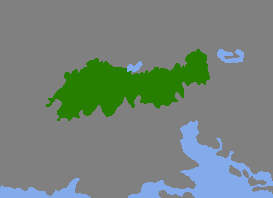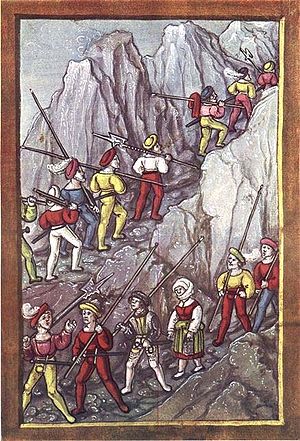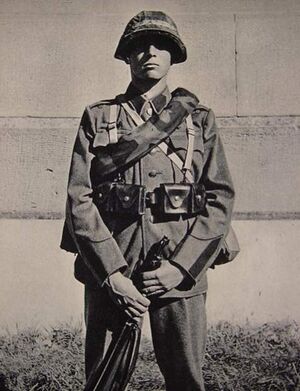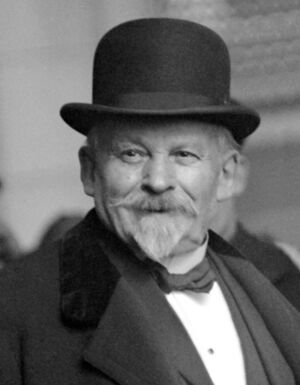Hercynia: Difference between revisions
| Line 140: | Line 140: | ||
==Geography== | ==Geography== | ||
<gallery> | |||
HercGeography.png|Mountain ranges with valleys in between are the most common feature of Hercynian landscapes. | |||
HercGeography0.png|Berg Daath is one of the highest castles in Hercynia, part of a 11 series of castles going up mount Dholys, tasked with also providing protection for the capitol city of Pleroma. | |||
HercGeography1.png|Even the Hercynian lowlands are considerably higher than most other regions. | |||
HercGeography2.png|Hercynia technically has one coastline, which is a lake between Hercynia and Allestag, commonly called Lak Eisgel. Pictured here is the lake town of Lakusdon, or, literally, "laketown." | |||
</gallery> | |||
Hercynia encompasses the majority of the middle of the Viridic Mountain range, and because of the wide variety in landscapes, individual regions within Hercynia usually tend to have much variation in temperature and climate that is heavily dependent on their altitude. The majority of the country is incredibly mountainous as well, with the rest of the country generally consisting of valleys and hillscapes, though small patches of plains are more common in the far eastern and far western areas of Hercynia. | Hercynia encompasses the majority of the middle of the Viridic Mountain range, and because of the wide variety in landscapes, individual regions within Hercynia usually tend to have much variation in temperature and climate that is heavily dependent on their altitude. The majority of the country is incredibly mountainous as well, with the rest of the country generally consisting of valleys and hillscapes, though small patches of plains are more common in the far eastern and far western areas of Hercynia. | ||
Revision as of 02:01, 14 June 2020
This article is incomplete because it is pending further input from participants, or it is a work-in-progress by one author. Please comment on this article's talk page to share your input, comments and questions. Note: To contribute to this article, you may need to seek help from the author(s) of this page. |
Enlightened Kingdom of Hercynia İlustra Tҕægesom Hrsinƣ-ҕėnke (Hercynian) Ilastrah Trégisom Hrsinrenki | |
|---|---|
|
Flag | |
| Motto: "Dħɐrɐkst ɐnɐdos Dæʢosæ." "Closer to God." | |
| Anthem: Dħɐrɐkst ɐnɐdos Dæʢosæ "Closer to God" | |
 Hercynia within Cybellum. | |
| Capital and largest city | Pleroma |
| Official languages | Hercynian |
| Recognized languages | Hellian Alpanian Hellian |
| Ethnic groups | Hercynian- 89% Altish- 3% Aventines- 3% Auvernians- 1.5% Other- 3.5% |
| Religion | Hercynian Folk Religion- 45% Hercynian Catholic- 52% Other - 3% |
| Demonym(s) | Hercynian |
| Government | Absolute Monarchy |
• Tréagi | Hardin II |
| Pehushon Ribelva | |
| History | |
• First Peoples | 5,000 BC |
• Founding of the Hercynian Federation | 851 AD |
• Founding of the Kingdom of Hercynia | 959 AD |
• The Southern Rebellion | 1011 AD |
• King Garlas' Conversion | 1013 AD |
• College of Wizards Foundation | 1257 AD |
• Wars of Religion | 1290-1520 AD |
• Ninety Years' War | 1520-1610 AD |
• The Enlightenment Schism | 1682-1701 AD |
• The National Reform | 1735 AD |
• "The Opening" | 1758 AD |
• Clementine Wars | 1799-1822 AD |
• War of the Grand Coalition | 1912-1919 AD |
• Collegiate Schism | 1931 AD - |
| Population | |
• 1936 estimate | 11,450,000 |
| GDP (PPP) | estimate |
• Total | 239,178,955,020 |
| GDP (nominal) | estimate |
• Total | 23,122.5 |
| Driving side | right |
THIS PARAGRAPH IS SO I DO NOT GET FINED THIS PARAGRAPH IS SO I DO NOT GET FINED THIS PARAGRAPH IS SO I DO NOT GET FINED THIS PARAGRAPH IS SO I DO NOT GET FINED THIS PARAGRAPH IS SO I DO NOT GET FINED THIS PARAGRAPH IS SO I DO NOT GET FINED THIS PARAGRAPH IS SO I DO NOT GET FINED THIS PARAGRAPH IS SO I DO NOT GET FINED THIS PARAGRAPH IS SO I DO NOT GET FINED THIS PARAGRAPH IS SO I DO NOT GET FINED THIS PARAGRAPH IS SO I DO NOT GET FINED THIS PARAGRAPH IS SO I DO NOT GET FINED THIS PARAGRAPH IS SO I DO NOT GET FINED THIS PARAGRAPH IS SO I DO NOT GET FINED THIS PARAGRAPH IS SO I DO NOT GET FINED THIS PARAGRAPH IS SO I DO NOT GET FINED THIS PARAGRAPH IS SO I DO NOT GET FINED THIS PARAGRAPH IS SO I DO NOT GET FINED THIS PARAGRAPH IS SO I DO NOT GET FINED THIS PARAGRAPH IS SO I DO NOT GET FINED THIS PARAGRAPH IS SO I DO NOT GET FINED THIS PARAGRAPH IS SO I DO NOT GET FINED
Etymology
The modern term Hercynia derives from the ancient Cybello-Aryavar term Erkunia, or Ėrkóƣ which originally pertained to a local tract of forest in south-central Hercynia. The While the forest has been destroyed due to human civilization over the millennia, the Erkunian forest is believed by scholars to have originally covered most of mainland Cybellum.
Due to the remote and difficult to access location of most of modern day Hercynia, linguistic distancing and cut-off evolution eventually changed the term from "Erkunia" to "Herkinia," or Hrkinƣ. This is believed to have taken place by the time of the Alpanian Republics founding in 500 BC. Afterward, by the time of the founding of the Hercynian Federation in 851, the term had evolved into the modern Hercynian Hrsinƣ.
Hercynian's complex grammar leaves terminologies relating to ownership in the case of nationality as suffixes at the end of the word. The full terminology of İlustra Tҕægesom Hrsinƣ-ҕėnke, or the "Enlightened Kingdom of Hercynia," derives from the words İlustra meaning "enlightened, bright" or "vibrantly illustrated," and Tҕægesom, or "Traégi's-dominion/Traégi's home." Hrsinƣ-ҕėnke itself means "Hercynian Realm." Яėnke is roughly analogous to the Altenic "Reich," the Reynish "Realm," Alpanian "Regnum," and the Freijian "Rijk."
Hercynian, compared to other Cybello-Aryavar languages, has been classified as the least evolved out of all of them. Please see the language section for more information.
History
Like many other nations, Hercynia has a history that is both very rich and lengthy. Originally starting off as a very loose confederation of tribes, modern Hercynia can be traced back quite far, with the first inhabitants of the region coming many millennia ago.
Hercynia has existed as a state in one form or another consistently since 851 AD, when the Hercynian Confederation, a long stretching alliance of various mountain tribes and feudal holdings, was founded. Over 100 years later, the Kingdom of Hercynia, the current form of Hercynia's statehood, was founded in 959 AD.
It is important to note that, due to Hercynia's incredibly superstitious nature, that certain important aspects of Hercynian culture may be conjecture or mythology. Likewise, given Hercynia's incredibly rough terrain and the overall philosophy of it's ruling classes, Hercynian history tends to be much more inwardly focused.
Early History and Alpania
The first recorded peoples entered Hercynia millennia ago, though as of 1930 most archaeological evidence points to the first major tribal "evolution" happening around 5,000 BC, when agriculture became relatively permanent. Various tribes began to farm wheat, barley, other grains, and a few types of fruits as well. Sheep and goats were the most common form of livestock.
Hercynian Federation
Kingdom of Hercynia, King Garlas, and the Southern Rebellion
The College of Wizards and the Wars of Religion
Ninety Years War
Period of Reform
Clementine Period
Neutrality in the War and the Collegiate Schism
Geography
Hercynia encompasses the majority of the middle of the Viridic Mountain range, and because of the wide variety in landscapes, individual regions within Hercynia usually tend to have much variation in temperature and climate that is heavily dependent on their altitude. The majority of the country is incredibly mountainous as well, with the rest of the country generally consisting of valleys and hillscapes, though small patches of plains are more common in the far eastern and far western areas of Hercynia.
Many tall mountains exist in the center and eastern regions of Hercynia, with the largest of them being Mount Dholys, the tallest mountain in the world, at 7897 meters, or 25,909 feet.
Politics
The Hercynian political system is ancient and antiquated, originally coming from a tribal confederation that evolved into a kingdom mirroring many others in continental Cybellum. With the founding of the Wizards' College in 1257, Hercynia's political system found itself increasingly involved with various aspects of the college, and to this day the two remain largely intertwined. Most in the Hercynian government have been some sort of educator or collegiate student in the past.
Compared to many other governments, Hercynia's government does not give much funding to the departments pertaining to foreign affairs. Instead, given it's neutral position, Hercynia's government tends to focus inwards.
Government
Political Factions
Foreign Relations
Judiciary and Law Enforcement
Military
The military of Hercynia is rather unique compared to other Cybellian militaries. When inside the borders of Hercynia, the Hercynian military (Hercynian: Miλⴽ Hrsinƣ-ҕėnke or "Milts Hrsinrenke") functions as a primarily defensive and policing force, and it generally spends its time preforming training, civil building projects, or policing the local populace.
The military is divided up into four sections. These are the Army, or "Milts," the Internal Security Board (Hercynian: İnd𐒉 Miλⴽ Ξėrdөs, "Indja Milts Kwehrdois"), the Royal Guard (Hercynian: Tréagᐱ Ξėrdөs, "Treagew Kwehrdois"), and the Air Force (Hercynian: Por𐒉 Ξėrdөs, "Porjaa Kwehrdois"). Of these, the largest is without a doubt the general Army, which is tasked with most of domestic and foreign issues pertaining to defense. The Internal Security Board, or the IhMKw, is tasked with more domestic disputes. While they don't police the general populace like the general Army do, they work more as detectives and as heavily armed police working to weed out internal strife and internal dissidents. They commonly are dispatched in response to cases of "black magic," or rogue witches or wizards attempting to curse people. The Royal Guard, as its name would suggest, is made to protect the Royal Family and other important government and Collegiate figures. The Air Force, while small, is made to provide an initial level of defense against possible invasion.
Outside of Hercynia, soldiers from the military, commonly referred to colloquially as "Milts" generally find themselves in the service of foreign nations. Owing to a large mercenary history stretching back to before the founding of the Hercynian Federation, individual Hercynian army regiments are generally hired out by various foreign powers to preform many tasks on their behalf. These can include colonial patrols, capturing forts, counterinsurgency, assassination, and more. Owing to Hercynia's neutrality, Hercynian regiments can be hired by any nation provided that they are paid well enough for their services, and Hercynian mercenaries served in the War of the Grand Coalition on both sides. This "foreign service" is commonly referred to as Gosti Ambigat, or GosAm for short.
Hercynian soldiers are required to follow a "code of honor" when serving outside the Kingdom, in which individual regiments are required to never fire on one another, get in the way of another regiment, or overall cause disruptions that would negatively affect Hercynia on the world stage. As would be expected, this foreign service has caused numerous diplomatic incidents between Hercynia and other countries, especially Altenland, Alytaj, Auvernia, and the SIA. In recent years, foreign interventions in Nymeria and Aestia have caused the majority of these diplomatic incidents.
In the Army and Royal Guard, service is generally open only to men, though since The Opening, individual regiments have been allowed to recruit women into their ranks for the purposes of espionage, support, or frontline combat. The Air Force and IhMKw both openly recruit women into their ranks.
Demographics
Ethnic Groups and Languages
The main ethnicity within Hercynia are Hercynians, a Cybello-Ayravar group who are believed to have originated from the Velivoi steppes millennia ago. Having conquered, displaced, and intermarried with the native old Cybelleans, the Hercynians proceeded to rule over them for a time before the smaller old Cybelleans were assimilated into ancient Hercynian culture. The Hercynians comprise about 89-90% of Hercynia's total population, and they speak Hercynian as their primary language.
Apart from the ethnic Hercynians, the lowlands and border regions have small numbers of Auvernians, Aventines, and Altish peoples living within the nations, generally as farmers or urban laborers. In total, they comprise about 7-7.5% of the total population of Hercynia. Most of these peoples, with the exception of those living in the lowest lowlands right on the border, generally speak Hercynian in their day to day lives, but use their native languages at home. In recent decades, however, there have been efforts to "Hercynize" these groups, and most of these regional minorities, especially the youth, are being culturally assimilated into mainstream Hercynian culture.
Due to the College of Wizards being one of the most widely renowned educational institutions in the world, there are many foreigners from across the world who reside in Hercynia for educational purposes. In total, about 3% of the total Hercynian populace is of foreign origin at any given time. Most commonly these peoples come from Sophia, Alytaj, Volkhov, Saidokamanagar, Kefalion, the United Provinces, southeastern Tellures, and Anzulab. Hercynia maintains a relatively flexible policy on immigration, but only in relation to the Colleges. Provided they can "prove their worth," anyone from anywhere can apply to the College of Wizards. Notable foreigners include Armando Cabrerra, a noted politician, and Yohannes Tedesse Zekai, the head of the Philosophical University. While most students return home, if capable of doing so, foreigners who wish to remain in Hercynia are able to provided they assimilate into mainstream Hercynian culture and society. They are also required to serve at least 3 years of military service with the Milts, and generally work as local guides, translators, or more.
Religion
Healthcare
Healthcare in Hercynia is rather unique when compared to neighboring Cybellean nations. Generally considered to be slightly above the Cybellean standard of healthcare on the standard of technology, Hercynian healthcare is considered to be, like many other things in the nation, to have a heavy spiritualist slant. Alongside standard medical procedure, most Hercynian physicians in both urban and rural areas make heavy usage of shaman-like practices and self-hypnosis or autosuggestion to manage pain post surgery.
In addition, antibiotics such as penicillin, while new discoveries, are used in tandem with more traditional forms of medicine to treat physical trauma.










